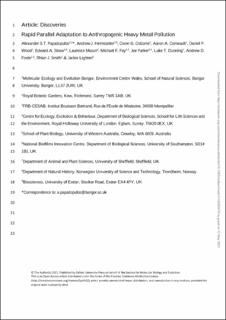| dc.contributor.author | Papadopulos, Alexander | |
| dc.contributor.author | Helmstetter, A. | |
| dc.contributor.author | Osborne, Owen | |
| dc.contributor.author | Comeault, Aaron | |
| dc.contributor.author | Wood, Daniel | |
| dc.contributor.author | Straw, Edward | |
| dc.contributor.author | Mason, Laurence | |
| dc.contributor.author | Fay, Michael F | |
| dc.contributor.author | Foote, Andrew | |
| dc.contributor.author | Parker, Joe | |
| dc.contributor.author | Dunning, Luke | |
| dc.contributor.author | Smith, Rhian | |
| dc.contributor.author | Lighten, Jackie | |
| dc.date.accessioned | 2021-05-12T09:17:27Z | |
| dc.date.available | 2021-05-12T09:17:27Z | |
| dc.date.created | 2021-05-05T21:03:29Z | |
| dc.date.issued | 2021 | |
| dc.identifier.issn | 0737-4038 | |
| dc.identifier.uri | https://hdl.handle.net/11250/2755126 | |
| dc.description.abstract | The impact of human-mediated environmental change on the evolutionary trajectories of wild organisms is poorly understood. In particular, species’ capacities to adapt rapidly (in hundreds of generations or less), reproducibly and predictably to extreme environmental change is unclear. Silene uniflora is predominantly a coastal species, but it has also colonised isolated, disused mines with phytotoxic, zinc-contaminated soils. To test whether rapid, parallel adaptation to anthropogenic pollution has taken place, we used reduced representation sequencing (ddRAD) to reconstruct the evolutionary history of geographically proximate mine and coastal population pairs and found largely independent colonisation of mines from different coastal sites. Furthermore, our results show that parallel evolution of zinc tolerance has occurred without gene flow spreading adaptive alleles between mine populations. In genomic regions where signatures of selection were detected across multiple mine-coast pairs, we identified genes with functions linked to physiological differences between the putative ecotypes, although genetic differentiation at specific loci is only partially shared between mine populations. Our results are consistent with a complex, polygenic genetic architecture underpinning rapid adaptation. This shows that even under a scenario of strong selection and rapid adaptation, evolutionary responses to human activities (and other environmental challenges) may be idiosyncratic at the genetic level and, therefore, difficult to predict from genomic data. | en_US |
| dc.language.iso | eng | en_US |
| dc.publisher | Oxford University Press (OUP) | en_US |
| dc.rights | Navngivelse 4.0 Internasjonal | * |
| dc.rights.uri | http://creativecommons.org/licenses/by/4.0/deed.no | * |
| dc.title | Rapid Parallel Adaptation to Anthropogenic Heavy Metal Pollution | en_US |
| dc.type | Peer reviewed | en_US |
| dc.type | Journal article | en_US |
| dc.description.version | publishedVersion | en_US |
| dc.source.journal | Molecular Biology and Evolution (MBE) | en_US |
| dc.identifier.doi | https://doi.org/10.1093/molbev/msab141 | |
| dc.identifier.cristin | 1908314 | |
| dc.description.localcode | © The Author(s) 2021. Published by Oxford University Press on behalf of the Society for Molecular Biology and Evolution. This is an Open Access article distributed under the terms of the Creative Commons Attribution License (http://creativecommons.org/licenses/by/4.0/), which permits unrestricted reuse, distribution, and reproduction in any medium, provided the original work is properly cited. | en_US |
| cristin.ispublished | true | |
| cristin.fulltext | postprint | |
| cristin.qualitycode | 2 | |

